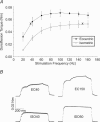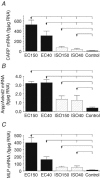Stress-dependent and -independent expression of the myogenic regulatory factors and the MARP genes after eccentric contractions in rats
- PMID: 16239282
- PMCID: PMC1464283
- DOI: 10.1113/jphysiol.2005.093005
Stress-dependent and -independent expression of the myogenic regulatory factors and the MARP genes after eccentric contractions in rats
Abstract
The relationship between muscle mechanical conditions and gene expression was investigated by varying both stress and contraction mode imposed upon rat dorsiflexors (n= 25), activating them at high or low frequencies (150 Hz or 40 Hz) either eccentrically or isometrically. Muscle physiological, immunohistochemical and gene expression changes were then measured 24 h after the exercise bout. Peak stress was the best predictor of muscle injury, independent of contraction mode (i.e. eccentric or isometric). When peak stresses were matched, no physiological or immunohistochemical differences were detected between isometric and eccentric contractions. The expression of certain myogenic regulatory and muscle ankyrin repeat protein (MARP) genes (myoD, myogenin, MLP and CARP) depended both on peak muscle stress achieved during contraction and contraction mode. In contrast, Arpp/Ankrd2 was dramatically upregulated only by eccentric contractions, but not by isometric contractions, even though the stress level of the eccentric contractions varied over a three-fold range and overlapped with that of the isometric group. The role that Arpp/Ankrd2 upregulation plays in the biological response to eccentric contraction remains to be determined, as does the control mechanism whereby the expression of certain genes (such as myoD, myogenin, MLP and CARP) is sensitive to muscle stress while another (Arpp/Ankrd2) is sensitive only to contraction mode.
Figures





Similar articles
-
Structural and regulatory roles of muscle ankyrin repeat protein family in skeletal muscle.Am J Physiol Cell Physiol. 2007 Jul;293(1):C218-27. doi: 10.1152/ajpcell.00055.2007. Epub 2007 Mar 28. Am J Physiol Cell Physiol. 2007. PMID: 17392382
-
Rapid muscle-specific gene expression changes after a single bout of eccentric contractions in the mouse.Am J Physiol Cell Physiol. 2004 Feb;286(2):C355-64. doi: 10.1152/ajpcell.00211.2003. Epub 2003 Oct 15. Am J Physiol Cell Physiol. 2004. PMID: 14561590
-
Combined isometric, concentric, and eccentric resistance exercise prevents unloading-induced muscle atrophy in rats.J Appl Physiol (1985). 2007 Nov;103(5):1644-54. doi: 10.1152/japplphysiol.00669.2007. Epub 2007 Sep 13. J Appl Physiol (1985). 2007. PMID: 17872405
-
Muscle ankyrin repeat proteins: their role in striated muscle function in health and disease.Crit Rev Clin Lab Sci. 2011 Sep-Dec;48(5-6):269-94. doi: 10.3109/10408363.2011.643857. Crit Rev Clin Lab Sci. 2011. PMID: 22185618 Review.
-
Mechanisms of muscle injury gleaned from animal models.Am J Phys Med Rehabil. 2002 Nov;81(11 Suppl):S70-9. doi: 10.1097/00002060-200211001-00008. Am J Phys Med Rehabil. 2002. PMID: 12409812 Review.
Cited by
-
FKBP12 deficiency reduces strength deficits after eccentric contraction-induced muscle injury.J Appl Physiol (1985). 2008 Aug;105(2):527-37. doi: 10.1152/japplphysiol.01145.2007. Epub 2008 May 29. J Appl Physiol (1985). 2008. PMID: 18511525 Free PMC article.
-
Nuclear actin and actin-binding proteins in the regulation of transcription and gene expression.FEBS J. 2009 May;276(10):2669-85. doi: 10.1111/j.1742-4658.2009.06986.x. FEBS J. 2009. PMID: 19459931 Free PMC article. Review.
-
Anisotropic regulation of Ankrd2 gene expression in skeletal muscle by mechanical stretch.FASEB J. 2010 Sep;24(9):3330-40. doi: 10.1096/fj.10-158386. Epub 2010 May 4. FASEB J. 2010. PMID: 20442316 Free PMC article.
-
Muscle injury after repeated bouts of voluntary and electrically stimulated exercise.Med Sci Sports Exerc. 2008 Sep;40(9):1605-15. doi: 10.1249/MSS.0b013e3181788dbe. Med Sci Sports Exerc. 2008. PMID: 18685531 Free PMC article. Clinical Trial.
-
Force per active area and muscle injury during electrically stimulated contractions.Med Sci Sports Exerc. 2008 Sep;40(9):1596-604. doi: 10.1249/MSS.0b013e3181757182. Med Sci Sports Exerc. 2008. PMID: 18685532 Free PMC article.
References
-
- Arber S, Halder G, Caroni P. Muscle LIM protein, a novel essential regulator of myogenesis, promotes myogenic differentiation. Cell. 1994;79:221–231. - PubMed
-
- Ashton-Miller JA, He Y, Kadhiresan VA, McCubbrey DA, Faulkner JA. An apparatus to measure in vivo biomechanical behavior of dorsi- and plantarflexors of mouse ankle. J Appl Physiol. 1992;72:1205–1211. - PubMed
-
- Banes AJ. Mechanical strain and the mammalian cell. In: Frangos JA, editor. Physical Forces and the Mammalian Cell. San Diego: Academic Press; 1993. pp. 81–123.
-
- Barash IA, Mathew L, Chen J, Lieber RL. Rapid muscle-specific gene expression changes after a single bout of eccentric contractions in the mouse. Am J Physiol Cell Physiol. 2004;286:C355–C364. - PubMed
MeSH terms
Substances
LinkOut - more resources
Full Text Sources
Research Materials

